
Wuchang is one of 13 urban districts of the prefecture-level city of Wuhan,the capital of Hubei Province,China. It is the oldest of the three cities that merged into modern-day Wuhan,and stood on the right (southeastern) bank of the Yangtze River,opposite the mouth of the Han River. The two other cities,Hanyang and Hankou,were on the left (northwestern) bank,separated from each other by the Han River.
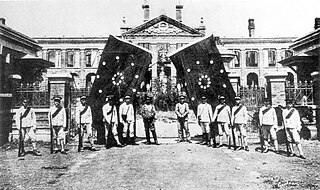
The Wuchang Uprising was an armed rebellion against the ruling Qing dynasty that took place in Wuchang in the Chinese province of Hubei on 10 October 1911,beginning the Xinhai Revolution that successfully overthrew China's last imperial dynasty. It was led by elements of the New Army,influenced by revolutionary ideas from Tongmenghui. The uprising and the eventual revolution directly led to the downfall of the Qing dynasty with almost three centuries of imperial rule,and the establishment of the Republic of China (ROC),which commemorates the anniversary of the uprising's outbreak on 10 October as the National Day of the Republic of China.

Huguang was a province of China during the Yuan and Ming dynasties. It was founded by the Yuan dynasty in 1274. During the Yuan dynasty it included the areas of modern Hubei south of the Yangtze river,Hunan,Guizhou,and Guangxi. During the Ming dynasty it came to include just the modern provinces of Hubei and Hunan,in the process adding areas north of the Yangtze. It was partitioned in 1644 by the newly established Qing dynasty,becoming the provinces of Hubei and Hunan,which were administered by the viceroy of Lianghu.
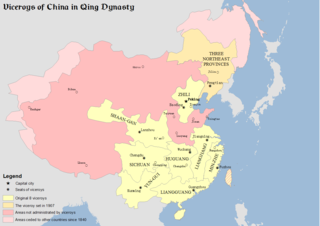
Zongdu were high-level officials responsible for overseeing the governors of several provinces in Ming and Qing China. One viceroy usually administered several provinces and was in charge of all affairs of military,food,wages,rivers,and provincial governors within their region of jurisdiction. Viceroys were appointed by and directly reported to the Emperor.
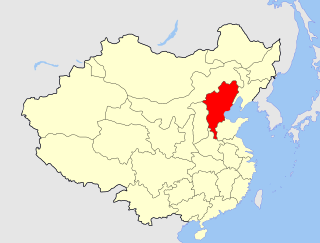
The Viceroy of Zhili,officially in Chinese as the Governor-General of the Directly Subordinate Province and Other Local Areas,in Charge of Military Affairs,Food and Wages,Management of Rivers and Governor Affairs, was one of eight regional Viceroys during the Qing dynasty. The Viceroy of Zhili had jurisdiction of military,civil,and political affairs over then Zhili Province. The Governor's Office sat in then Zhili Province's Baoding Prefecture City.
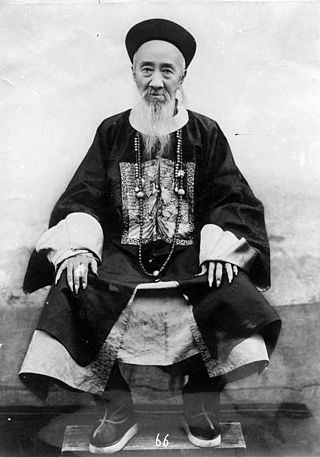
Zhang Zhidong was a Chinese politician who lived during the late Qing dynasty. Along with Zeng Guofan,Li Hongzhang and Zuo Zongtang,Zhang Zhidong was one of the four most famous officials of the late Qing dynasty. Known for advocating controlled reform and modernization of Chinese troops,he served as the governor of Shanxi Province and viceroy of Huguang,Liangguang and Liangjiang,and also as a member of the Grand Council. He took a leading role in the abolition of the Imperial examination system in 1905. The Red Guards destroyed his tomb in 1966 during the Cultural Revolution. His remains were rediscovered in 2007 and reburied.

The Viceroy of Liangguang,fully in Chinese as the Governor-General of Two Guang Provinces and Other Local Areas,in Charge of Military Affairs,Food and Wages and Governor Affairs,was one of eight regional Viceroys during the Ming and Qing dynasties of China. The Viceroy of Liangguang had jurisdiction of military,civil,and political affairs over then Guangdong Province and then Guangxi Province.

The Viceroy of Liangjiang,fully named in Chinese as the Governor-General of the Two River Provinces and Other Local Admirals,in Charge of Military Affairs,Food and Wages,Management of Rivers,and Administration on Nanhe Affairs,was one of eight regional Viceroys during the Qing dynasty. The Viceroy of Liangjiang had jurisdiction of military,civil,and political affairs over then Jiangnan Province and then Jiangxi Province. The position was set up in 1647 and abolished in 1912.
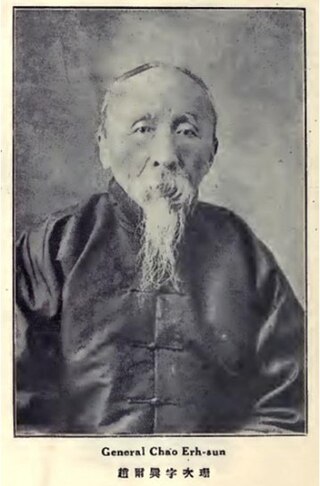
Zhao Erxun,courtesy name Cishan,art name Wubu,was a Chinese political and military officeholder who lived in the late Qing dynasty. He served in numerous high-ranking positions under the Qing government,including Viceroy of Sichuan,Viceroy of Huguang,and Viceroy of the Three Northeast Provinces. After the fall of the Qing dynasty,he became a historian and was the lead editor of the Draft History of Qing.
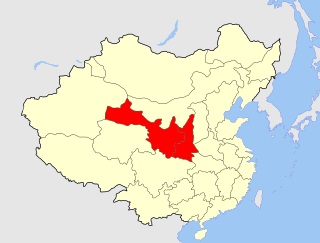
The Viceroy of Shaan-Gan,fully in Chinese as the Governor-General of Shaanxi,Gansu and Other Local Areas,in Charge of Military Affairs,Food and Wages,Tea and Horses and Governor Affairs,was one of eight regional Viceroys during the Qing dynasty. The Viceroy of Shaan-Gan had jurisdiction of military,civil,and political affairs over then Shaanxi Province and then Gansu Province.
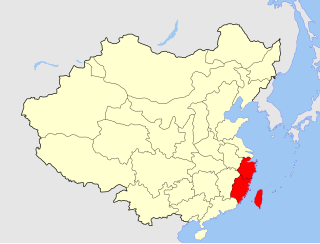
The Viceroy of Min-Zhe,fully in Chinese as the Governor-General of Min-Zhe Provinces and Other Local Areas,in Charge of Military Affairs,Food and Wages and Governor Affairs,was one of eight Viceroys during the Qing dynasty. The Viceroy of Min-Zhe had jurisdiction of military,civil,and political affairs over then Fujian Province,Zhejiang Province,and Taiwan Province.

The Viceroy of Yun-Gui,fully in Chinese as the Governor-General of Yun-Gui Provinces and Other Local Areas,in Charge of Military Affairs,Food and Wages and Governor Affairs,was one of eight regional Viceroys during the Qing dynasty of China. The Viceroy of Yun-Gui had jurisdiction of military,civil,and political affairs over then Yunnan Province and then Guizhou Province.

The Viceroy of Sichuan,fully in Chinese as the Governor-General of Sichuan and Other Local Areas,in Charge of Military Affairs,Food and Wages and Governor Affairs,was one of eight regional Viceroys during the Qing dynasty. The Viceroy of Sichuan had jurisdiction of military,civil,and political affairs over then Sichuan Province.
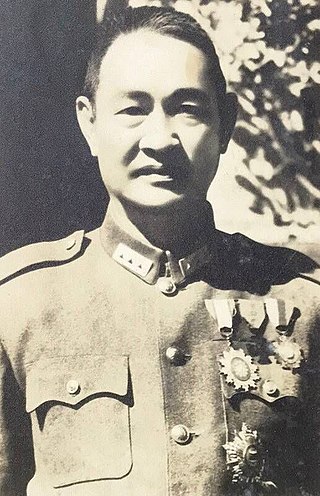
Cheng Qian was a Chinese army officer and politician who held important military and political positions in both the Republic of China and the People's Republic of China. Educated at the Imperial Japanese Army Academy and Waseda University,he first met Sun Yat-sen in Tokyo,becoming an early supporter. Later,under Chiang Kai-shek,he was one of the most powerful members of the Kuomintang,notably serving as Chief of Staff of the Military Affairs Commission during the Second Sino–Japanese War.
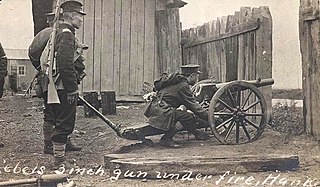
The Battle of Yangxia,also known as the Defense of Yangxia,was the largest military engagement of the Xinhai Revolution and was fought from October 18 to November 27,1911,between the revolutionaries of the Wuchang Uprising and the loyalist armies of the Qing dynasty. The battle was waged in Hankou and Hanyang,which along with Wuchang collectively form the tri-cities of Wuhan in central China. Though outnumbered by the Qing armies and possessing inferior arms,the revolutionaries fought valiantly in defense of Hankou and Hanyang. After heavy and bloody fighting,the stronger loyalist forces eventually prevailed by taking over both cities,but 41 days of determined resistance by the Revolutionary Army allowed the revolution to strengthen elsewhere as other provinces defied the Qing dynasty. The fighting ended after the commander-in-chief of the Qing forces,Gen. Yuan Shikai,agreed to a cease-fire and sent envoys to peace talks with the revolutionaries. Political negotiations eventually led to the abdication of the Last Emperor,the end of the Qing dynasty and the formation of a unity government for the newly established Republic of China.
Meng Caicheng was one of the leaders of the Railway Protection Movement,which contributed to the outbreak of the Xinhai Revolution that overthrew the Qing Dynasty and established the Republic of China.
A list of historical events that took place in China in the year 1880.
Yue Zhongqi was a Chinese military commander of the Qing dynasty. He was a descendant of the Song dynasty general Yue Fei,and served as Minister of War and Viceroy of Chuan-Shaan during the reign of the Yongzheng Emperor.
Events from the year 1668 in China.
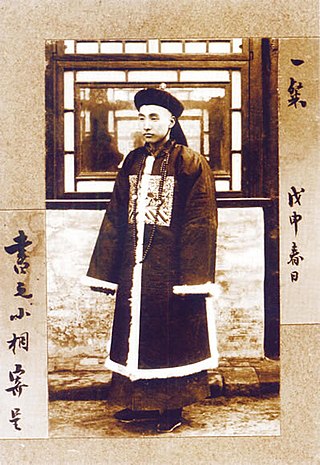
The Qing dynasty (1644–1912) was the last imperial dynasty of China. The early Qing emperors adopted the bureaucratic structures and institutions from the preceding Ming dynasty but split rule between the Han and Manchus with some positions also given to Mongols. Like previous dynasties,the Qing recruited officials via the imperial examination system until the system was abolished in 1905. The Qing divided the positions into civil and military positions,each having nine grades or ranks,each subdivided into a and b categories. Civil appointments ranged from an attendant to the emperor or a grand secretary in the Forbidden City (highest) to being a prefectural tax collector,deputy jail warden,deputy police commissioner,or tax examiner. Military appointments ranged from being a field marshal or chamberlain of the imperial bodyguard to a third class sergeant,corporal or a first or second class private.








































